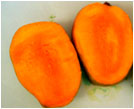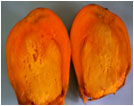Physiological
disorders
|
Spongy tissue in Alphonso mango
|
|
The cause of spongy tissue
formation in Alphonso mango was identified for the first
time in the world. Physiological and biochemical
studies have firmly established that the disorder is
caused due to the premature onset of
germination-associated events in the seed during fruit
maturation on the tree/ post-harvest ripening stages.
Based
on crucial experimental evidence, 70% fruit maturation
stage was identified as the critical phase of fruit
growth at which the transition to germination occurs in
Alphonso mango. Results have conclusively shown that a
reduced content of seed fats during fruit growth led to
a reduced concentration of Very Long Chain Fatty Acids
(VLCFAs) like, tetracosanoic acid (C 24) and
hexacosanoic acid (C 26). These, in turn, triggered an
increased production of cytokinins in seed eventually
leading to premature germination while seeds with the
normal fat content produced higher level of VLCFAs and
hence germination occurred after full maturity of fruit. The above finding is of paramount
importance for effective prevention of ST disorder since
treatment of developing fruits on the tree should be
completed before the onset of seed germination events.....More
|
 Healthy Healthy |
|
|
 Spongy Spongy |
|
|
|
|
Jelly seed, a
physiological disorder in Amrapali
|
|
Seed hormones estimated by HPLC showed that the
concentrations of GA and IAA were higher 3 in jelly seed
(JS) affected Amrapali mango compared to healthy seed
while ABA was higher in healthy seed. The activities of
starch phosphorylase, amylase and acid phosphatase
enzymes were significantly higher in jelly seed compared
to healthy seed. Acid phosphatase is involved in the
generation of inorganic phosphate needed for the action
of starch phosphorylase which converts stored starch
into simple sugars. Concurrently, the contents of total
and reducing sugars in seed of jelly seed affected
fruits showed an increase (70.3 and 24.1 units )
compared to HS (62.7 and 20.5 units), while starch
content decreased from 377.5 units in HS to 297.2 units
in JS, supporting the increased rate of degradation of
starch in JS seed. The activities of pectinolytic
enzymes like, PG and PME were found to be higher in JS
fruit pulp compared to H pulp showing that the rate of
degradation of pectin was higher in JS fruit compared to
H fruit which explained the jelly texture of the JS
affected fruit. The calcium content of the jelly seed
was higher at 379.6 mg/g compared to 238.1 mg/g in
healthy seed indicating the possible migration of the
element from pulp to seed during JS development. It was
clearly evident from the results that germination
associated events had begun in the seed of JS affected
fruit.
|
|
|
Vivipary
|
|
The data obtained with
respect to the close link existing between reduced seed
fat content, lowered levels of VLCFAs and stimulation of
cytokinin biosynthesis leading to premature germination
in Alphonso mango, offers a satisfactory explanation for
the occurrence of vivipary in mango, a characteristic
phenomenon wherein mango seed shows germination during
fruit ripening and storage.
|
Isolation of antioxidants from mango
kernel
|
|
A method for the isolation of kernel antioxidants from
defatted mango kernels was standardized. The yield of
antioxidants on dry weight basis was 10 to 12.5 %. DPPH
and FRAP activities of the isolated antioxidants were 30
and 10 % more than the ascorbic acid respectively. Total
flavonoids were 44.03 mg / g. Extracts were found to be
stable when heated up to 200° C for 30 min and when
boiled for 30 min in aqueous medium. The extracts were
also stable at pH 4 and pH 9. Measurement of acidulant
capacity of the extract showed that 0.1 % addition of
the extract to water decreased the pH to 4. Addition of
0.15% kernel antioxidants to biscuits prevented lipid
peroxidation by 62 % over control when tested after
three months of storage. The kernel antioxidants also
exhibited antibacterial activity against Bacillus cereus
and Enterobacter strains which are common food borne
pathogens.
|
Morpho-physiological
interventions to overcome staggered flowering in
Alphonso mango
|
|
Variable responses of tree shoots to similar
environmental stimuli appears to be one of the major
causes of staggered flowering behaviour in older
Alphonso mango trees. Observations on leaf net P
revealed that more than 70% of the N older leaves (> 6
to 8 months) on the tree were photosynthetically less
efficient (-7.7 to 1.5 µ moles m-2 s-1) compared to
younger leaves (3 to 11.5 µ moles m-2 s-1) irrespective
of the month in a year. Complete defoliation of trees
resulted in highly synchronized vegetative shoot
formation with the primordia getting activated within 5
to 7 days irrespective of the month in a year. On the
contrary, selective pruning of tertiary branches not
only resulted in the loss of active primordia but also
altered the canopy architecture. In defoliated trees,
the newly formed leaves were photosynthetically active
35-45 days after emergence and contributed consistently
to the buildup of carbohydrate reserves leading to
vegetative shoot formation and synchronized flowering.
Flowering occurred 30-50 days earlier compared to the
undefoilated trees. Flowering was not observed in those
trees which had flowered and yielded in the previous
year due to their alternate bearing nature. Trees that
were defoliated in 2012 flowered in the current year,
but the fruit number and yield were reduced by 30 to 50%
depending on the physiological status of the tree. Yield
data revealed that the average fruit weight was 250g in
the defoliated trees compared to 180g in the
undefoilated trees.
|
|
|